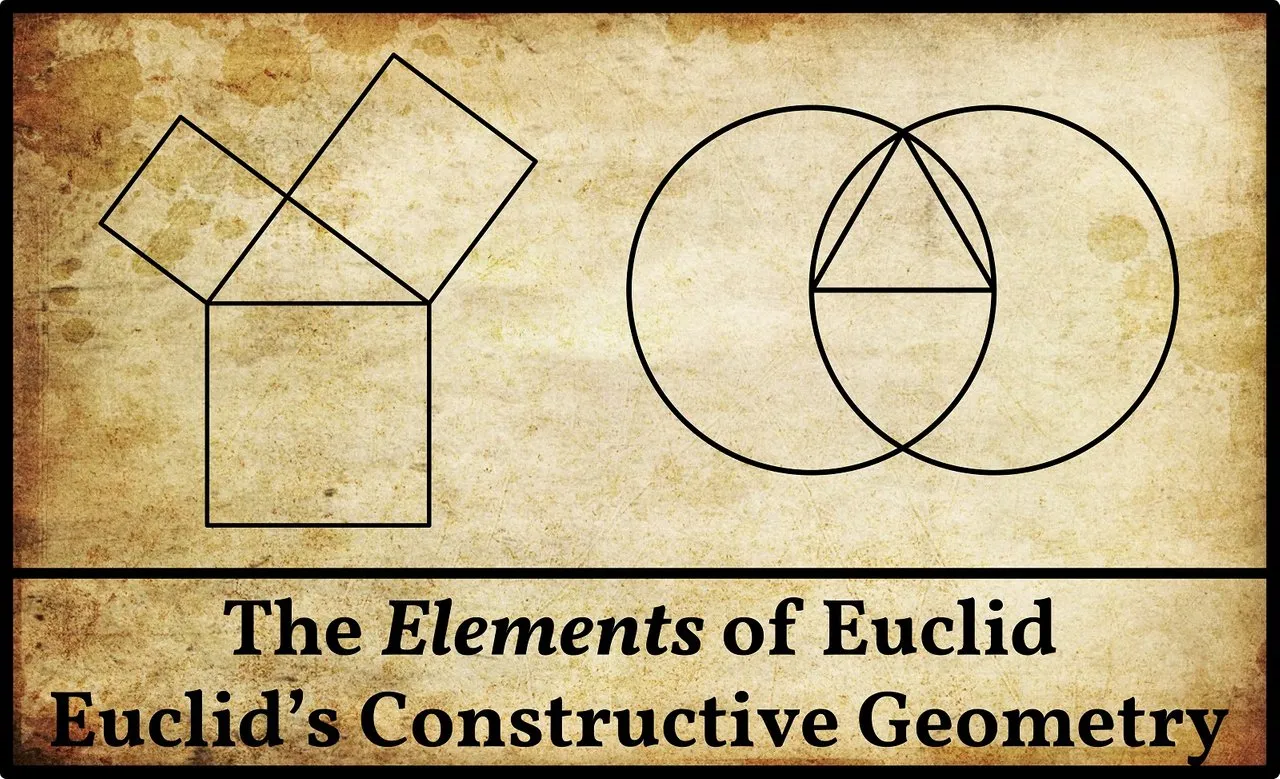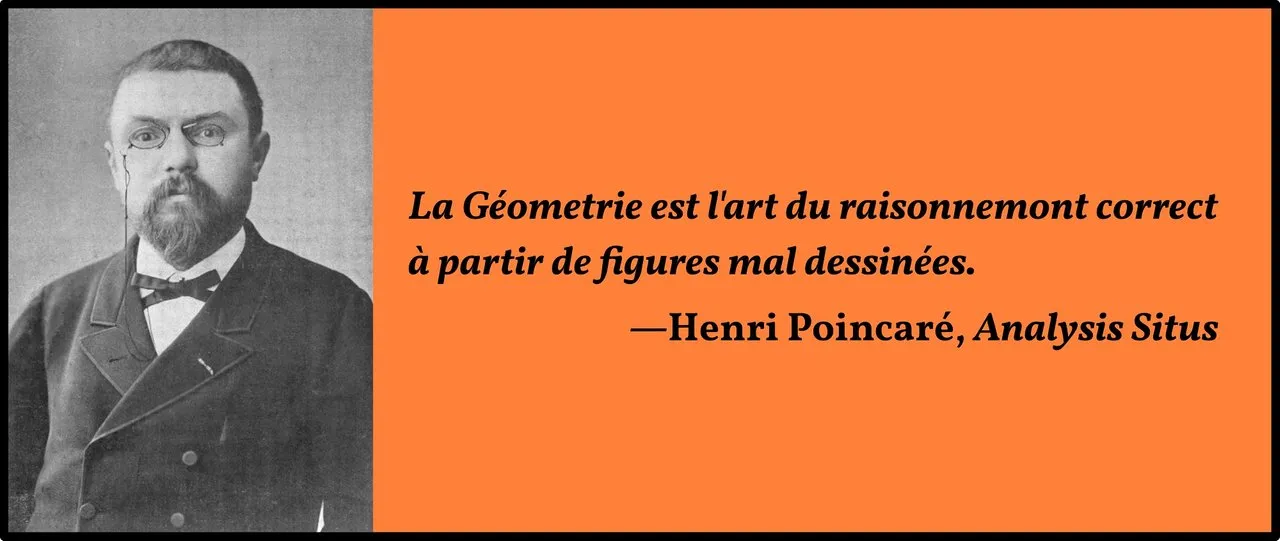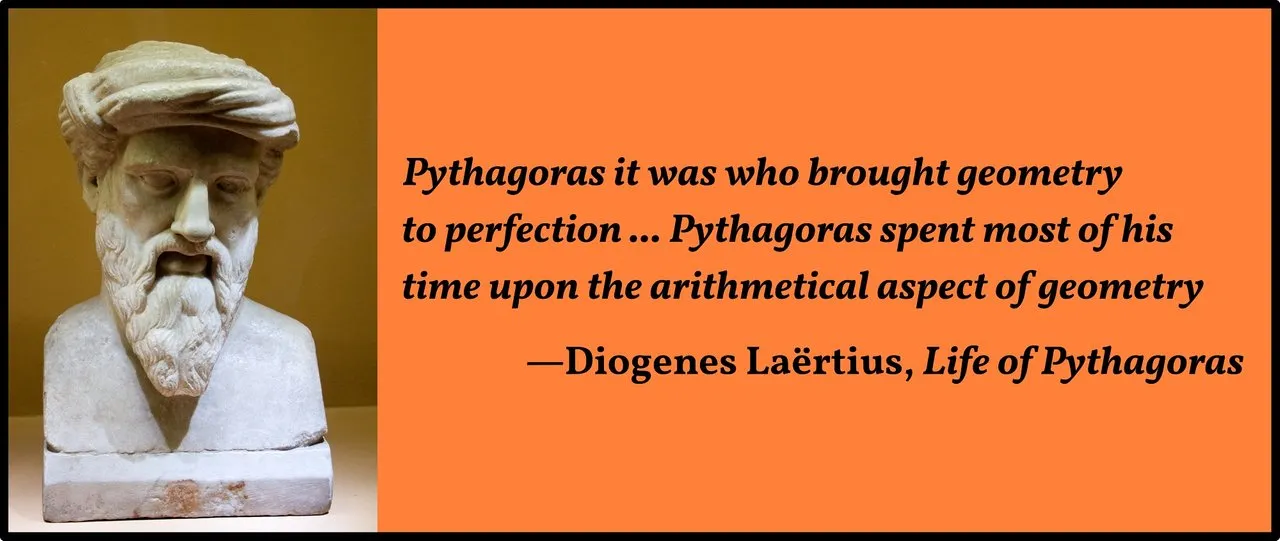
In the previous article in this series, we saw that Euclid’s Elements is often said to constitute an axiomatic system—albeit a flawed one. Alternatively, Euclid’s approach to geometry is sometimes described as constructive. What does this term signify and is it justified?
Euclidean geometry, as presented by Euclid, consists of straightedge-and-compass constructions and rigorous reasoning about the results of those constructions ... The phrase “constructive geometry” suggests, on the one hand, that “constructive” refers to geometrical constructions with straightedge and compass. On the other hand, the word “constructive” may suggest the use of intuitionistic logic. (Beeson 19 ... 20)
It is not uncommon to find the term Euclidean Geometry defined as any geometry that can be constructed using only a compass and a straightedge:
Euclidean Geometry is constructive. Postulates 1, 2, 3, and 5 assert the existence and uniqueness of certain geometric figures, and these assertions are of a constructive nature: that is, we are not only told that certain things exist, but are also given methods for creating them with no more than a compass and an unmarked straightedge. (Euclidean Geometry)
In mathematics, a constructive proof is a method of proof that demonstrates the existence of a mathematical object by creating or providing a method for creating the object. (Constructive Proof)
But nowhere in the thirteen books of the Elements does Euclid mention either a compass or a straightedge. In A Short Account of the History of Mathematics, W R Ball admits tacitly that while Euclid may not have explicitly mentioned the compass or straightedge, he nevertheless:
admitted only those constructions which could be made by the use of a ruler and compasses. [Footnote: The ruler must be of unlimited length and not graduated; the compasses also must be capable of being opened as wide as is desired.] (Ball 56)

The compass, which is used to construct circles, is sometimes described as a collapsible compass: it collapses when lifted from the page, so that it may not be used to transfer distances. This restriction, however, is unnecessary, as even a collapsing compass can be used to transfer distances using a multi-step procedure (Straightedge-And-Compass Construction).
It can also be shown that Euclidean Geometry can be performed without the use of the straightedge: all of Euclid’s constructions can be carried out using only a compass.
Another curiosity of the Elements is the manner in which Euclid expresses his constructions. Nowhere does he employ the simple imperative mood—Draw a circle with centre Α and radius ΑΒ. Instead, he goes out of his way to employ an ungainly and rarely used form of the Greek verb: the third person imperative. This occurs in three different voices (active, middle and passive) and in three different tenses (present, perfect and aorist):
Third person imperatives are as common in Euclid as they are rare in the usual Greek texts (J B Calvert)
Some examples from Richard Fitzpatrick’s translation include the following:
Let it have been postulated ...
Let the circle BCD with center A and radius AB have been drawn ...
Let ABC be a circle, and let two points A and B have been taken at random on its circumference.

Are these just interesting facts about Euclid’s method or do they force us to rethink our entire approach to Euclidean geometry? Why does Euclid not mention the straightedge or the compass if these are the tools of the Euclidean geometer? Why does he not simply instruct his reader to carry out the necessary geometric constructions?
One possible explanation is that Euclid was keenly aware of the difference between geometric objects and pictorial representations of geometric objects. For example, a circle, qua geometric object, is an abstract idea. You cannot see a real circle. You cannot construct a real circle with the help of a compass. The marks you make with chalk on a blackboard or with ink on a piece of paper do not constitute a circle. They merely represent a circle. Hence, when Euclid writes Let a circle have been drawn, he is referring to a real circle—created, perhaps, by Plato’s demiurge, or by Apollo, or Athena.
There is also a crucial difference between a general geometric object and a particular instance of a geometric object. For example, when we say that the three internal angles of a triangle are equivalent to two right angles, the term triangle is here akin to a Platonic form, embracing all possible instances of actual triangles. If we tried to demonstrate this property by drawing a diagram, we would necessarily have to draw a specific triangle, letting it stand for all the others. So, when Euclid writes in 1:32, Let ABC be a triangle, he is talking of a general triangle with vertices ABC, and not the specific triangle that any diagram must depict.
Did Euclid’s original manuscript have diagrams? It is generally thought that it did (Ornes). Since the nineteenth century, Euclid has even been accused of drawing general conclusions from particular diagrams, or of using his diagrams to establish results intuitively rather than to prove them rigorously (Avigad 12, Ornes 12355).

Diagrammatic Reasoning
Danielle Macbeth of Haverford College, Pennsylvania, is another philosopher who has argued that Euclid’s geometry is constructive rather than axiomatic, but she has taken the concept of constructive geometry into hitherto uncharted waters:

In an axiomatic system, a list of axioms is provided (perhaps along with an explicitly stated rule or rules of inference) on the basis of which to deduce theorems. Axioms are judgments furnishing premises for inferences. In a natural deduction system one is provided not with axioms but instead with a variety of rules of inference governing the sorts of inferential moves from premises to conclusions that are legitimate in the system. In the case of natural deduction, one must furnish the premises oneself; the rules only tell you how to go on. The question, then, whether Euclid’s system is an axiomatic system or not is a question about how the definitions, postulates, and common notions that are laid out in advance of Euclid’s demonstrations actually function, whether as premises or as rules of construction and inference. Do they function to provide starting points for reasoning, as has been traditionally assumed? Or do they instead govern one’s passage, in the construction, from one diagram to another, and in one’s reasoning, from one judgment to another? Inspection of the Elements suggests the latter. In Euclid’s demonstrations, the definitions, common notions, and postulates are not treated as premises; instead they function, albeit only implicitly, as rules constraining what may be drawn in a diagram and what may be inferred given that something is true. They provide the rules of the game, not its opening positions. (Macbeth 237)
According to Macbeth, the first three postulates tell us what we may draw when we are constructing a geometric diagram:
- Let it have been postulated to draw a straight-line from any point to any point.
- And to produce a finite straight-line continuously in a straight-line.
- And to draw a circle with any center and radius. (Fitzpatrick 7)
The first postulate allows us to connect any two distinct points with a line segment. The second postulate allows us to extend any line segment indefinitely. And the third postulate simply tells us that we may draw a circle with any point as centre and any (non-zero) distance as radius.

Bertrand Russell refers to the third postulate as Euclid’s postulate of the existence of the circle (Russell 444), but according to Macbeth, Euclid is not postulating the existence of the circle—he defines the circle in Definition 15. He is simply giving the geometer a rule to follow when constructing a valid geometric diagram:
In each case, one’s starting point—points, circles, and lines—must be supplied from elsewhere in order for the postulate to be applied. And nothing can be done, at least at first, that is not allowed by one of these postulates. But once they have been demonstrated, various other rules of construction can be used as well. For instance, once it has been shown, using circles, lines, and points, that an equilateral triangle can be constructed on a given finite straight line (proposition I.1), one may in subsequent constructions immediately draw an equilateral triangle, without any intermediate steps or constructions, provided that one has the appropriate line segment. Propositions such as I.1 that solve construction problems function in Euclid’s practice as derived rules of construction. Once they have been demonstrated, they can be used in the construction of diagrams just as the postulates themselves. (Macbeth 237-238, edited)
Macbeth goes on to argue that the first three of Euclid’s common notions are rules of inference:
- Things equal to the same thing are also equal to one another.
- And if equal things are added to equal things then the wholes are equal.
- And if equal things are subtracted from equal things then the remainders are equal. (Fitzpatrick 7)
Furthermore, in this case as well, theorems, once demonstrated, can function in subsequent demonstrations as derived rules of inference. Once it has been established that, say, the Pythagorean theorem is true (I.47), one may henceforth infer directly from something’s being a right triangle that the square on the hypotenuse is equal to the sum of the squares on the sides containing the right angle. Indeed, Euclid’s Elements is so called because the totality of its theorems and constructions provide in this way the elements, rules, for more advanced mathematical work. (Macbeth 238)

According to Macbeth, Definitions can also license inferences (Macbeth 238). But not every rule is explicitly stated. Euclid often makes inferences that are obviously valid but without stating the rules on which such inferences depend. He also frequently requires one to read relevant geometrical objects off his diagrams without any explicitly stated rule for doing so:
Furthermore, in order to follow a demonstration in Euclid, one must read various things off the relevant diagrams, again according to rules that seem nowhere to be stated. For example, given two lines that cross, or cut one another, in a diagram, Euclid assumes that there is a point at their intersection. The point of intersection seems simply to “pop up” in the diagram as drawn, and is henceforth available to one in the course of one’s reasoning. (Macbeth 239)
Macbeth sums up the essence of this diagrammatic approach to geometry in the following way:
Although nothing can be put into a diagram that is not licensed by one of the given postulates or a previous construction, there seem to be no stated rules governing what, in the way of pop-up objects, can be taken out of it. (Macbeth 241)
Macbeth’s diagrammatic interpretation of Euclid also explains why Euclid never mentions a straightedge or a compass in the Elements. It is essentially for the same reason I gave above. The diagrams are merely pictorial representations of geometric objects—icons with non-natural meaning, in the technical language which Macbeth borrows from C S Peirce—so it really makes no difference whether we use a compass to draw a circle or simply draw it by hand. A “circle” drawn with the help of a compass may look neater than one drawn by hand, but neither of them is a real circle (Macbeth 246-247).

In conclusion:
A Euclidean demonstration is not, then, diagram-based, its inferential steps licensed by various features of the diagram. It is properly diagrammatic. One reasons in the diagram, in Euclid, that is, through lines, dia grammon, just as the ancient Greeks claimed ...a Euclidean demonstration, as we have come to understand it, is not a proof in the standard sense at all; it is not, that is, a sequence of sentences some of which are premises and the rest of which follow in a sequence of steps that are deductively valid, or diagram-based. Indeed, the demonstration does not lie in sentences at all. It lies in a certain activity, in a course of reasoning focused directly on a diagram. And this activity is needed, we have seen, because it alone can actualize the potential of the diagram to yield something new. The diagram, the actual marks on the page (or some appropriate analogue), must be seen now this way and now that if the result that is wanted is to be achieved. (Macbeth 265-266)
And that’s a good place to stop.
References
- Jeremy Avigad, The Role of the Diagram in Euclid’s Elements, Department of Philosophy and Department of Mathematical Sciences, Carnegie Mellon University, Pittsburgh (2008)
- Walter William Rouse Ball, A Short Account of the History of Mathematics, Dover publications, New York (1960)
- Michael Beeson, Constructive Geometry, Proceedings of the 10th Asian Logic Conference, pp 19-84, World Scientific Publishing Co Pte Ltd, Singapore (2010)
- Richard Fitzpatrick (translator), Euclid’s Elements of Geometry, University of Texas at Austin, Austin, TX (2008)
- Thomas Little Heath (translator & editor), The Thirteen Books of Euclid’s Elements, Second Edition, Dover Publications, New York (1956)
- Johan Ludvig Heiberg, Heinrich Menge, Euclidis Elementa edidit et Latine interpretatus est I. L. Heiberg, Volumes 1-5, B G Teubner Verlag, Leipzig (1883-1888)
- Danielle Macbeth, Diagrammatic Reasoning in Euclid’s Elements, Philosophical Perspectives on Mathematical Practice, College Publications, Rickmansworth, Hertfordshire (2010)
- Stephen Ornes, Researchers Find History in the Diagrams of Euclid’s Elements, Proceedings of the National Academy of Sciences of the United States of America, Volume 114, Number 47, pp 12353-12355, NAS, Washington, DC (2017)
- Marco Panza, The Twofold Role of Diagrams in Euclid’s Plane Geometry, Synthese, Volume 186, Number 1, pp 55-102, Springer Verlag, Berlin (2012)
- Henri Poincaré, Analysis Situs, Œuvres de Henri Poincaré, Tome 6, pp 193-288, Gauthier-Villars, Paris (1953)
- Bertrand Russell, The Principles of Mathematics, Routledge, Abingdon, Oxfordshire (2010)
Image Credits
- George Washington’s Compass, © 2021 Heritage Auctions, Fair Use
- Henry David Thoreau’s Straightedge, Daderot (photographer), Concord Museum, Concord, MA, Public Domain
- Geometry is the Art of Correct Reasoning from Badly Constructed Diagrams: Henri Poincaré, Public Domain
- Danielle Macbeth: © 2021 Haverford College, Fair Use
- Bertrand Russell, James Francis Horrabin (artist), Public Domain
- Pythagoras: Roman Bust of Pythagoras, Musei Capitolini, Rome, Szilas (photographer), Public Domain
- Giotto Painting a Circle by Hand for Pope Benedict XI: Italian School, 19th Century, Public Domain
Online Resources
